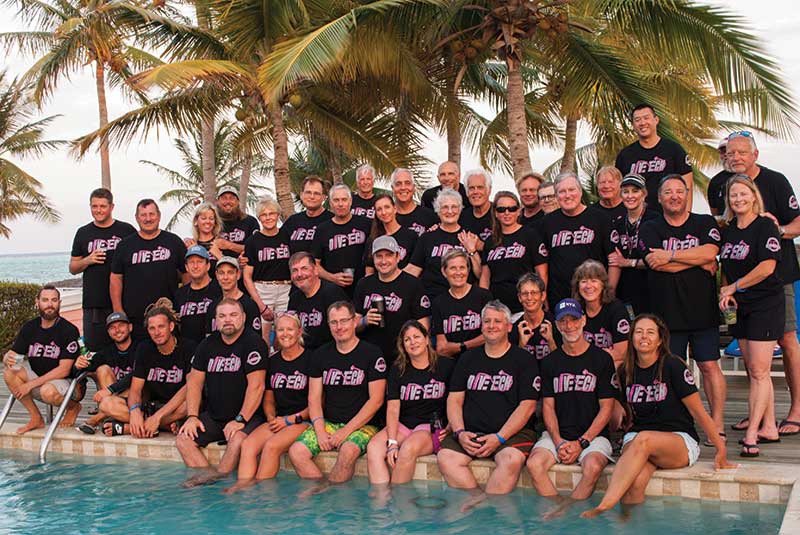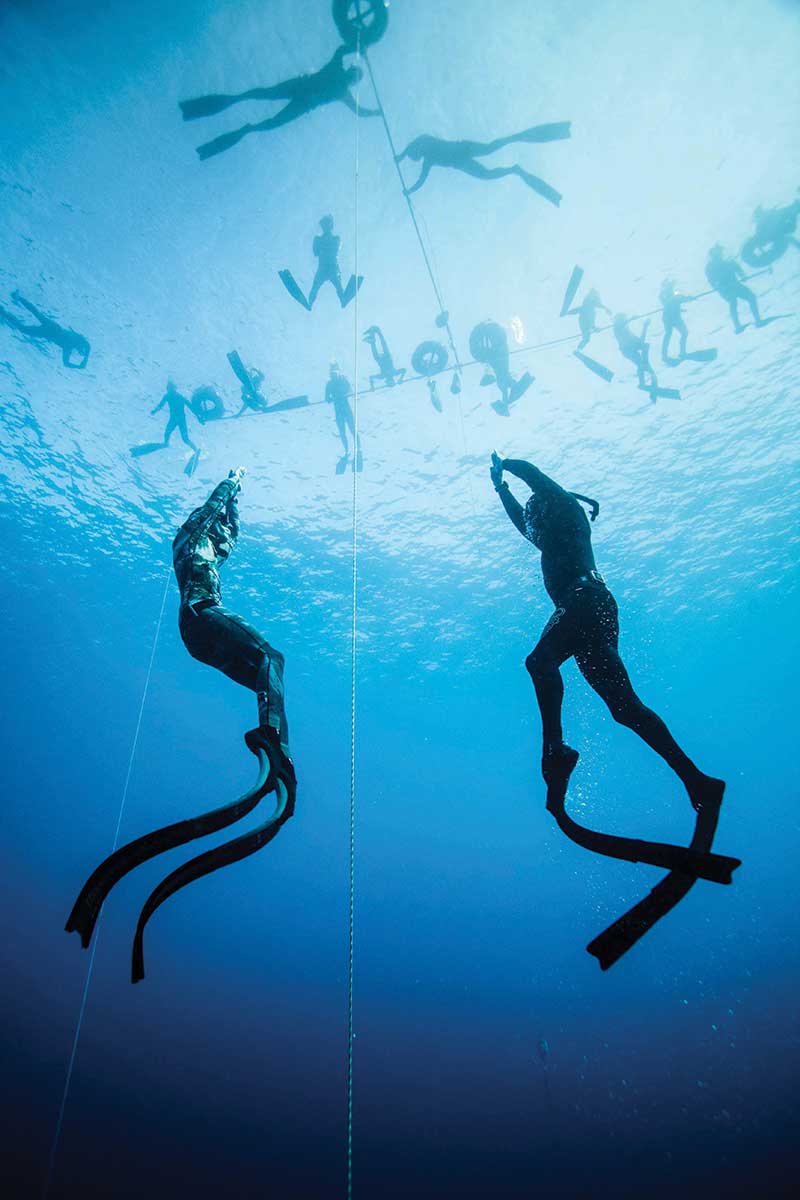Cayman: The Test of Time
As we reminisce about our love for dive travel, we got hooked on the many memories forged in one of the world’s most popular destinations. So why are the Cayman Islands a favourite for so many?
Words by Drew McArthur

Imagine turning up for your first ever scuba lesson only to find that the tank you would be breathing from had been converted from an old fire extinguisher. Furthermore, the makeshift cylinder, filled by a compressor out of a WWII bomber, would be strapped to you using a homemade wooden frame. Back in 1957 when Bob Soto opened the first dive operation in Grand Cayman, that’s how things were done. As sketchy as it may seem by modern standards, the local legend’s ingenuity catapulted the Cayman Islands into the forefront of the dive scene. Since then, decades have passed, the industry has changed, and opportunities for diving elsewhere in the world have flourished, so how has this destination managed to pass the test of time and remain a favourite for so many?
For as long as dive magazines have existed, readers have been blown away by stunning images of the walls that surround each of the three Cayman Islands. Steep drop offs that plunge from the perfectly clear blue water down into the darkness of the unknown abyss below make an incredible backdrop for the vibrant coral, giant sponges, turtles, sharks, schools of jacks, and so much more.
World-class restaurants and bars, solid infrastructure, low crime, easy going locals, and—of course—exceptional diving have continued to attract tens of thousands of divers each year…well, until that whole pandemic thing kicked off, anyway. A notable behaviour of the islands’ visitors in the pre-COVID world was the amount of returning clientele, with many scheduling trips on a yearly basis.

Diversity appeal
One such couple of buddies are husband and wife dive team Seth & Diane, whose Cayman adventure began back in the 80s. Diane recalls, “In ’88, ’91 and ’93 I went to dive on the Cayman Aggressor with my former dive buddy, Janet. I fell in love with Bloody Bay Wall in Little Cayman and also the north wall of Grand Cayman.”
In ’95 her husband Seth took the plunge and got certified, and since then the pair have managed to bounce around the world, racking up thousands of dives together along the way. With log book stamps that include (but are not limited to) St Kitts, Turks & Caicos, Hawaii, Fiji and Palau, the fact that the couple continue to return to the Cayman Islands with regularity speaks volumes. Seth says, “We’ve been diving all over the world. While comparisons are tricky, one thing that has always set Cayman apart is its diversity.”
Granted, you can’t do ice diving in the Cayman Islands. And with the highest elevation on Grand Cayman being a dizzy 59 feet (18m), altitude diving is out, too. But there is something available to scratch the itch of most other scuba cravings. The shape of the island group delivers stretches of water that have minimal wave movement or currents. For this reason, each year, hordes of people begin a new adventure by donning scuba gear for the first time and dipping their toes in the warm tranquil waters. Just feet below the surface, pretty reefs with abundant tropical fish life lure newbies into the sport hook line and sinker.

Just a stone’s throw away from the vibrant shallow reefs is the drop of the wall that has been the playground for deep technical diving explorers for decades. The islands are home to an annual rebreather event called Innerspace, which is a prominent feature in the closed circuit community calendar. Around fifty rebreather divers join local dive operator Divetech each year to explore as deep as 330 feet (100m).
While the deep adventurers in that niche area of the industry draw upon their wealth of training and experience to safely negotiate such depths, the crew aboard boats just hundreds of feet away help divers into the world famous 10-foot (3m) dive at Stingray City.
Stingray City does what it says on the tin. Strictly speaking, there are actually two stingray cities. One is a sandbar that is waist deep in calm water and usually popular with the cruise ship industry, whereas the other one reaches the scary depths of just-above-head-height. In both cases, visitors have the opportunity to be up close and personal with southern stingrays in what has become an exceptionally popular activity. It’s a unique experience that can’t be found anywhere else.

Freedive mecca
It isn’t just the depths and animal encounters that bring diversity to the table. For some time, the islands’ scuba community has fostered emerging areas of the sport. Diane recalls stumbling across another niche chapter of diving while staying in Cobalt Coast one year, “We came downstairs to get breakfast before diving and saw what looked like a dozen or so dead bodies floating face down in the pool. Turns out it was the Canadian freediving team practicing for a big competition”.
Freediving is nothing new to the Cayman Islands. The local inhabitants have been using breath hold techniques for centuries to duck-dive for conch and to spear fish. But the annual freedive event Deja Blue sees contenders from all around the world compete here. Throughout the nine thrilling annual events so far, multiple world records have been set and then broken as participants push the absolute limits of their ability.
Organising events like Innerspace and Deja Blue aren’t tasks to be taken lightly. A variety of stakeholders need to sink considerable sums of money into such projects to pull them off, so organisers appreciate having as much going in their favour as possible to ensure the event takes place successfully. The dependability of factors like dive conditions have contributed to the continued popularity of the location. From promoters to group travel leaders, to family heads, to individuals; the reliability that comes with diving in Cayman offers a great deal of peace of mind when making future plans. That’s not to say that the country is exempt from bad weather—anywhere can experience a few grey days and stormy skies—but the amount of diving days that are cancelled each year due to harsh conditions are minimal. Most dive operators use a variety of docks spaced out around the island, so if the weather is coming in hard from one direction, they simply head to the opposite side.

Images of your desire
The reliability of the conditions also makes the islands a favourite for underwater photographers. Dedicated shutterbugs who have taken a dive trip to Cayman will appreciate that the visibility, light, motion, and presence of marine life are all going to be conducive (as much as they can be) to get the images they desire.
The sheer volume of high quality photography that flows out of the islands from both vacationing and resident divers has helped this reputation. From the photogenic wrecks of the Kittiwake, Doc Poulson or the Captain Keith Tibbetts to the close encounter with the rays in Stingray City, underwater shooters are spoilt for choice. The predictability of the stunning visibility also makes for awesome shots of the wall against the big blue. Throw a diver or an obliging turtle into the mix and it is possible to come out with a shot to please even the most self-critical of photogs.
The life on the reef is plenty for most photographers, but there are also many wrecks within comfortable depths just a skip away from the main docks. The most visited of Cayman’s wrecks is the ex-USS Kittiwake, a 251-foot (76.5m) submarine support & salvage vessel.
The Kittiwake could serve as a metaphor for the variety of diving in the Caymans: from snorkellers who float 25 feet (8m) above the shallowest point of the stunning wreck, to the certified divers exploring the insides, to the technical divers who return from the depths of the wall next to the wreck and use the vessel as an interesting place to burn off their deco. For those who prefer natural attractions, the wreck sits right next to the coral structure of the top of the wall and the sand on which the wreck rests is riddled with garden eels that draw in plenty of southern stingrays and eaglerays. The wreck attracts an interesting community of grouper, jacks, barracuda, parrotfish, and blue chromis—making a bustling explosion of life that thrives amongst the wreckage.

Caymankind
The good Mr. Soto passed away in 2015, but he left a legacy behind. During one of their many visits to Grand Cayman Seth & Diane were fortunate enough to have met the man behind the legend. After climbing out of the shore dive site Turtle Reef (where Macabuca now is) Diane was asked by a lady to go for drinks at a new bar. The lady turned out to be Bob’s wife Suzy and Diane recalls, “We came back, with a lot of friends from Cobalt Coast and Divetech and had the most memorable evening talking about old times and hearing the stories from the legendary Bob Soto, his wife and family. Simply a fantastic memory.”
It is this kind of inclusivity that has led to the endearing expression ‘Caymankind’. It personifies the warmth of the welcome that the good-spirited people of the islands like to shower upon their guests and is something that visitors to the island have come to know and love.
There are so many reasons why people continue to rank the Cayman Islands as their go-to destination, it is hard to single one out. On top of the excellent diving and topside activities, Seth & Diane sum it up by saying, “We come back because the people we’ve met over the years have made us feel like family. We’re not ‘tourists’ when we come to Cayman. We’re at our one particular harbour, our home away from home.”
Leave a Comment







